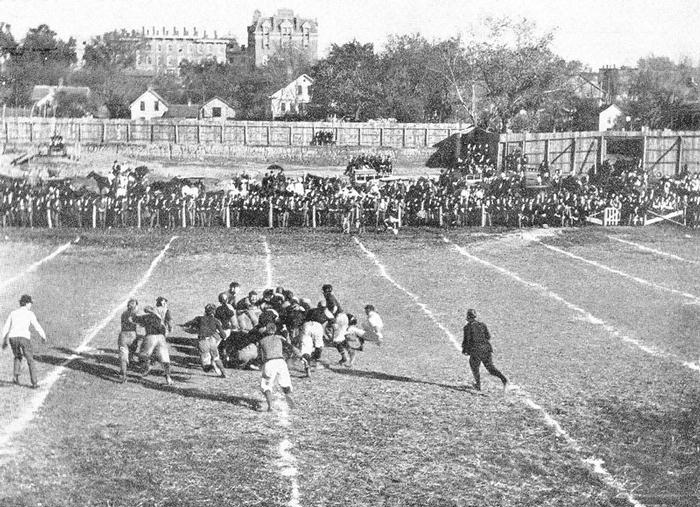
| JOHNSON COUNTY IAGenWeb Project |
Copyright 2003
By Bob Hibbs
Saturday
November 22, 2003
Saturday Postcard 221: Football Image Sparks Insight

Photo
courtesy Miriam Troyer of Kalona
The
University of Iowa’s 1900 championship gridiron team mixes it up with Drake
during
an Oct. 26 game on Athletic Park turf along the Iowa River below central Iowa
City.
The horizon is marked by 1863 South Hall (left) and 1882 Medical Building on
Pentacrest,
both destroyed by fire four months later.
|
By
Bob Hibbs
From
riverboat landing and football field to tower of learning and water spigot,
the Iowa River’s left bank below Old Capitol in Iowa City has witnessed
much.
Miriam
Troyer of Kalona recently produced evidence of one aspect of its history in a
marvelous 1900 image of a Drake-Iowa football game played Oct. 26, 1900. She
brought the image to a recent Questers Club gathering where this reporter was
guest speaker.
Two
red brick buildings from the University of Iowa’s formative years nearly
jump from the horizon. The
October date means the image was recorded only months before fire leveled
Pentacrest denizens South Hall and Medical Building on March 10, 1901.
A
substantial crowd at the game had no seats; it was caught standing along the
sidelines with teams tangling under the watchful eyes of three officials.
Fencing perhaps eight feet tall limits vision into a neighborhood now site of
the Becker and another communications studies building under construction.
The
field – now raised 10 feet – currently serves the UI English Philosophy
Building along Iowa Avenue, the UI Water Treatment Plant along Burlington
Street and a parking lot between them.
Although
hidden from view, a bleacher section which seated several hundred spectators
backed up to the river. The venerable Crandic Railway had yet to build its
tracks along the tall fence. That happened in 1904.
The
game came during Iowa’s first season in the Western Athletic Conference,
commonly called the Big Ten, during which Iowa won the league title.
That
1900 championship team notched seven wins without a defeat, although it was
tied by Northwestern, 5-5, in a game marked by apparently intentional food
poising of the Iowa team on the eve of the game by a Davenport hotel chef who
reportedly bet against the Hawks.
Iowa
scored 311 points in eight games, while allowing eight opponents like Chicago,
Michigan, Grinnell and Northwestern a total of only 12 points.
This
team might have played the inaugural Rose Bowl, except that the University of
California cancelled at the last minute. Michigan accepted similar invitation
the following year and beat Stanford in the first game of that holiday
classic.
Athletic
Park along the Iowa River was dedicated during the second game of the 1900
season played against an Iowa State team which Coach Alden Knipe’s Hawkeyes
shellacked 68-0.
The
site had been established in 1839 as a public “promenade” located west of
an unopened First Street right-of-way platted a block west of Madison Street.
First Street became route of the Crandic tracks.
Pioneers
hoped paddle-wheeler river boats would dock at the promenade, a dream realized
but on rare occasion during the 1840s and ‘50s before the railroad arrived
in Iowa City during the final minutes of 1855.
The
promenade eventually was sold into private hands, becoming known as the
Metzger lot, Englert Park and Sullivan Pasture, the latter fronting on
Burlington Street. The university optioned the Metzger parcel in 1892, Englert
Park the next year, and the Sullivan ground in 1895. It took title in 1897 to
all three.
Improvements
made during 1900 cost $1,500, likely including the west side bleachers. Huge
bleacher-type stands later would help handle crowds exceeding 25,000 during
1925, though many still stood.
Opening
of Kinnick Stadium with 42,500 seats in 1929 shifted the sports focus west; a
baseball diamond and oval track were built east of the stadium on ground now
occupied by University Hospitals. Trailer houses were moved onto the former
athletic park in 1946 in response to an explosion in UI enrollment following
WWII.
The
trailer court evolved into a parking lot, then into a building site and the
water plant existing today. Thus, an old image helps unfold the story of a
chunk of river bank in Iowa City. Many thanks, Miriam.
Next
Saturday: The battleships Iowa.
Bob
Hibbs collects local postcards and researches history related to them. |